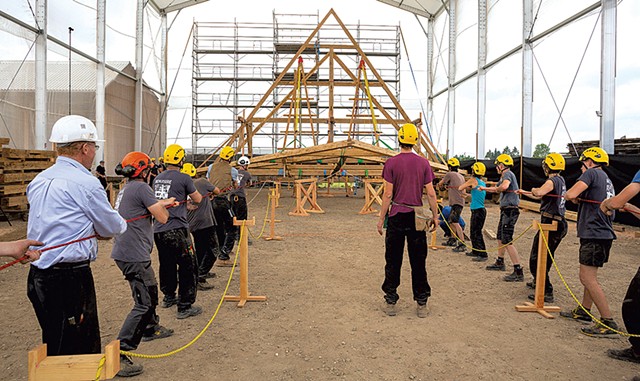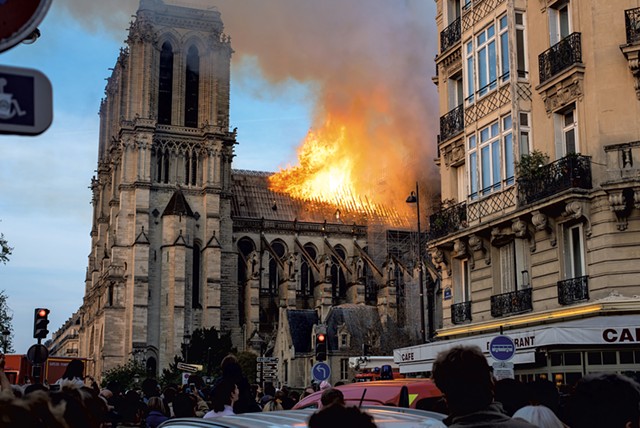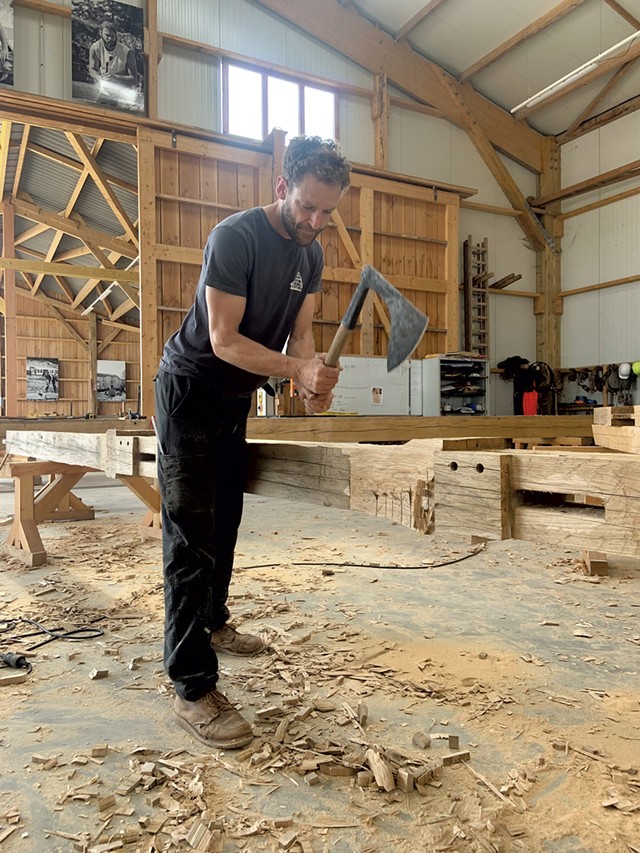
- Courtesy Of David Bordes
- Work crews rebuilding Notre-Dame cathedral
Normally, modern contractors don't aspire to using medieval techniques and materials. For Will Wallace-Gusakov, doing so was the career opportunity of a lifetime.
The 39-year-old carpenter from Lincoln spent the past six months in Normandy, France, swinging a Gothic-style broadax, hand-hewing oak beams and chiseling wood joinery as part of a massive reconstruction effort that's garnered international attention. Last year, Wallace-Gusakov was hired by some longtime French colleagues and friends to be part of an American crew of carpenters, including four Vermonters, who are helping to rebuild Notre-Dame de Paris, the famous medieval cathedral that was severely damaged by fire in 2019.
For Wallace-Gusakov, who got started in professional carpentry when he was a teenager in Bristol, rebuilding Notre-Dame's roof afforded him an opportunity to apply old-school woodworking techniques, some of which have been used in Vermont for centuries to build houses and barns, to one of Europe's most iconic structures.
"I kind of love all timber-frame geeky stuff, so I'm mostly self-taught," Wallace-Gusakov said in a phone interview from Normandy. But getting to work on a UNESCO World Heritage Site is "something that I never would have even dared to dream."
Wallace-Gusakov is the owner of Goosewing Timberworks in Lincoln, which specializes in traditional timber framing, fine carpentry, and antique building restoration and preservation. Though he's worked on other historic sites before, none was as large or complex as the landmark cathedral on Paris' Seine River, which holds a special place in the hearts of French citizens.
Those hearts collectively broke on the evening of April 15, 2019, when, during a maintenance project, a structure fire erupted in the cathedral's roof space and spread with astonishing speed and ferocity. As smoke billowed into the sky, Parisians turned out by the thousands to see the Gothic church engulfed in flames, while millions more watched live on televisions, computers and cellphones around the world. About an hour into the blaze, Parisians let out a collective gasp as the cathedral's 200-foot spire toppled into ruins.

- Matthew Lockhart
- The 2019 fire at Notre-Dame
Even before the last embers were extinguished, French President Emmanuel Macron set a five-year deadline for restoring the cathedral in time for the 2024 Summer Olympics in Paris; within two years, donors from around the world had raised nearly $1 billion toward the construction effort.
Whether Notre-Dame would be rebuilt was never in doubt. But as Wallace-Gusakov explained, the real question was how it would be done and what the finished product would look like. The fire ignited a public debate about whether the cathedral, a prime example of French Gothic architecture that was built between the 12th and 14th centuries, should include 21st-century touches and materials such as concrete and steel.
At odds were French General Jean-Louis Georgelin, whom Macron handpicked to oversee the project, and Philippe Villeneuve, the project's chief architect. Villeneuve was vehement that the cathedral be rebuilt precisely as it had looked before the fire; Macron and Georgelin favored adding contemporary elements.
Further complicating the debate was the fact that many of Notre-Dame's prefire features were themselves added centuries after the original construction; notably, the iconic spire that long adorned the Paris skyline actually was added in the mid-19th century following a resurgence of interest in the cathedral sparked by Victor Hugo's novel The Hunchback of Notre-Dame.
For many French carpenters and historic preservationists, modernizing the Gothic cathedral cut deeply against the grain. In the years after the fire, the international nonprofit group Charpentiers sans Frontières, or Carpenters Without Borders, launched a major push to rebuild it using traditional materials and techniques. In 2020, members of Carpenters Without Borders, with which Wallace-Gusakov has volunteered for six years, constructed a wooden truss by hand using the same methods that Notre-Dame's medieval carpenters would have used.
Ultimately, the traditionalists won out, and the decision was made to rebuild Notre-Dame's roof frames with hand-hewn carpentry, which essentially means cutting wooden beams with axes and chisels rather than a sawmill. That decision allowed Wallace-Gusakov's friends Rémy and Loïc Desmonts, a father-and-son team of traditional French carpenters in Normandy, to submit a bid. In April 2022 their company, Ateliers Desmonts, won the contract to rebuild the nave roof and choir roof timber frames. Last spring the Desmonts invited Wallace-Gusakov to join their crew.
The Bristol native was already experienced in French carpentry methods and styles. About a decade ago, he spent a year and a half working in France and learned the language. In fact, during one yearlong project in Paris, Wallace-Gusakov lived near Notre-Dame and would wait outside the cathedral each morning for the company van to drive him to his job site.
But he never went inside — until just a few weeks ago, to see the construction that's under way. Wallace-Gusakov returned to Normandy in January. There, as with the rest of the cathedral's carpentry, including that for the choir, transept and spire, the nave frame is being fabricated and test-assembled before it's disassembled and shipped to Paris later this summer.
"It's a crazy jobsite right in the middle of Paris," he said. "There's all this lead contamination there, so there's this whole process of safety briefings and hazmat suits to go in."

- Courtesy Of Will Wallace-Gusakov
- Will Wallace-Gusakov hand-hewing oak beams for the Notre-Dame nave roof frame
All the wood the carpenters are using is European oak, the same species as was used in the 1200s and 1300s. Wallace-Gusakov noted that not all the work is being done with medieval methods. With more than 1,000 workers involved, some are permitted to use modern techniques and machinery. Except for some photo ops staged for the press showing a few trees being felled with axes and two-person saws, Wallace-Gusakov noted, most were cut with modern logging equipment, and some power tools have been allowed. In all, 500 oak trees were felled for the nave alone, and another 1,000 for the new spire.
All those logs have to be hand-hewn with axes, with the finishing joinery also done by hand. The timber frame of Notre-Dame was significant in the development of Western timber framing for its systematic use of mortise and tenon joinery — that is, wood-to-wood joints, Wallace-Gusakov explained. (A mortise is the "female" part of a joint, with a notch, hole or cut into which the tenon, or "male" piece of another beam, is inserted.)
"The Notre-Dame cathedral actually happens to be very significant in the technical development of timber framing in Western Europe," he said, "which is really cool to work on."
While Wallace-Gusakov was accustomed to such building methods, he was not expecting the cathedral roof to be reproduced to the level of intricate detail that it is, a process he described as "very technically challenging." In addition to the massive amount of lumber that must be hand-hewn, laid out, stacked and sorted, the architects are using photos and historic records to rebuild the structure exactly as it looked before the fire, including all the flaws and "funky idiosyncrasies" from its medieval makers.
"Nothing is level or straight or plumb or planar, so every little thing is different from every other little thing," he said. For French architectural preservationists, he added, it's "a watershed moment that's pretty cool to be a part of."
The nave frame that Wallace-Gusakov constructed is a massive oak structure. At 115 feet long, 46 feet wide and 33 feet high, it's composed of 57 trusses forming 11 spans, according to the French authorities overseeing the project.
Given the niche nature of handworked carpentry, it's not surprising that Vermont is well represented on this project, said Miles Jenness of Vermont Heavy Timber in Huntington. The 36-year-old restoration timber framer has been working in Normandy for six months alongside Wallace-Gusakov and fellow Vermonters Zakari LeBlanc of Huntington and Josh Jackson of TimberHomes Vermont in Montpelier.
"There's not that many people in the world who do this sort of thing, so it's become a community," Jenness said. He first met Loïc Desmonts, the French carpenter, in August 2019 when both volunteered for a Carpenters Without Borders project in Sedgwick, Maine. After the project was completed, he invited Desmonts to stay at his home in Vermont for several weeks and do some work together.
Following the Notre-Dame fire, Jenness said, he was frustrated to read in repeated news stories that the skills used to build Notre-Dame had been lost and it wouldn't be possible to reproduce it the same way.
"This feels like a bit of a coup ... for the public to know that this sort of craft is not lost," he said. Jenness thinks it'll have a ripple effect on future historic restoration projects.
"To be able to show anyone who would say, 'Why would we restore it in the traditional way?' Well, look at Notre-Dame," he added. "If they could do it, so can we."
The first pieces of the nave frame will hit the road for Paris starting in August, with the entire frame being installed, bit by bit, over a five- to six-month period. Alas, Wallace-Gusakov, who came back to Vermont last week, won't be able to return to France to see his handiwork hoisted into the Paris sky; he has prior commitments, including a wife and two young boys, that will keep him in Vermont.
Asked whether this project had any religious or spiritual significance to him, Wallace-Gusakov said it did not.
"I'm quite aware that monumental architecture is, in some ways, a monument to inequality and, most times, slavery, too," he said. But aside from some "philosophical dissonance" he has about the darker elements of the cathedral's construction history, he added, "There are so many other wonderful things we're doing that I can get over that."









Comments
Comments are closed.
From 2014-2020, Seven Days allowed readers to comment on all stories posted on our website. While we've appreciated the suggestions and insights, right now Seven Days is prioritizing our core mission — producing high-quality, responsible local journalism — over moderating online debates between readers.
To criticize, correct or praise our reporting, please send us a letter to the editor or send us a tip. We’ll check it out and report the results.
Online comments may return when we have better tech tools for managing them. Thanks for reading.